Many creative personalities, who created a lot of masterpieces on canvas, dazzled countless figures of clay, created a lot of plot compositions on wooden surfaces, are ready to show their gift in other directions. For some, it will be interesting to work in the scrapbooking technique, others will appreciate calligraphy, and still others will be delighted with batik.
What it is?
Batik is a generalized term, suggesting several methods for hand-drawing on various types of fabric material. The principle of redundancy is taken as the basis of the described technique. In simple words a pattern is applied to the fabric, the contour of which is covered with a reserve composition that prevents the spreading of dyes on the surface of the base. Thanks to this feature, masters create patterns of any complexity.
As a border separator, a special composition of fixative is used, which is called reserve in the art world. The main components in its manufacture are gasoline, paraffin and a water base.



The technique of performing batik is based on the fact that components of the reserve, namely paraffin, rubber glue, various resins, do not allow the dye composition to pass through itself. For the work itself, cotton material, silk, woolen and synthetic fabrics are used as the basis of the working cloth. Most often, creative people try to transform clothes, for example, T-shirts or jeans.
To update old wardrobe items, kitchen towels and rag accessories, the technique of hand-painting on fabric is considered indispensable, while several types of designs are distinguished in batik, allowing you to work with different types of fabric and dye compositions.

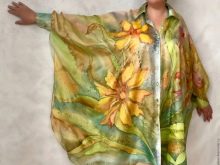

When creating a creative masterpiece, artistic natures are laid out to the maximum. Finished work is unique, vibrant and unique. It is worth noting that many artists who are professionally engaged in painting on fabric have managed to create their own clothing line, which is not possible to repeat.



History of occurrence
The origin of hand-painted fabric is Java. The very designation "batik" in the literal translation means "wax drops." The presented painting technique has been known to the Indonesian people since ancient times. Many of them still decorate their clothes, costumes of relatives and fabric household items with unique patterns.
In principle, humanity has long been engaged in the creation of images on fabric canvases. Various methods of applying the dyeing material to the fabric were known in Sumer, were used in Japan, Peru. In Sri Lanka and in parts of the African continent, the technique of applying paint to fabric was given special attention.


Despite the fact that the technology of applying images to matter was familiar to different nations, Indonesian masters were the first to comprehend the multiple subtleties of technology and reached unprecedented heights in the work of coloring matter. In a short period of time, they managed to turn an ordinary room craft into a whole direction of art.
The masters spent not a month on compiling an image of one canvas. Some quite complex drawings were created by artists for several years. And this has nothing to do with the laziness of the master. Basically, everything is tied to the multi-stage stages of preparing the main material. To begin with, it was necessary to soak it, and then boil it. Snow-white fabric, which was most often used to create masterpieces, needed to be bleached. Then, a sketch was applied to the fabric along the contour of which the wax composition was processed.
After it dries, the artist could begin to create colorful masterpieces. The last stage of work was drying the canvas. Due to the long and painstaking process of creating drawings, painted clothes were originally worn only by aristocrats and representatives of noble families.


The masters of Java did not want the fabric drawing technique to be forgotten after several decades. For this reason, they passed on the secrets of the creative craft to their offspring. Creative Javanese even conducted experiments, trying to reproduce the same patterns on identical types of fabric. Only nothing came of it. The finished works had similar features among themselves, and yet the difference in the execution of the drawing by different people was clearly visible.
In those ancient times, beginning batik masters initially used floral ornaments, the execution of which did not require much work. Having gained experience, the task of painting on fabric should be complicated by images with geometric patterns, and then proceed with the execution of storylines from mythological stories.
Scientific historians, after familiarizing themselves with and studying the emergence of batik technology, claim that it is clear from the images printed on a person’s clothing what class they belong to. At the same time, it was strictly forbidden to redraw the royal patterns.
Even in the dowry of the future bride there should have been at least one thing, decorated using the batik technique. It could be curtains, panels, any elements of the wardrobe. And since then, this rule has not changed much.

Today, hand-painted wardrobe items are especially popular among the Indonesian people.Due to the increased demand, clothes began to be made for sale in order to make a profit. It is important to note that in the 17th century, batik began to be exported from Java to European countries. Europeans appreciated the method of applying images to fabric and, in order to simplify the work of masters, invented a special unit - a batik-pin. He helped keep the wax liquid for a long period of time.
And already in 1801, an automatic device with punch cards was created, thanks to which a person could create paintings with ready-made thumbnails of images. Such a breakthrough played a serious role in the history of batik, because the technique of execution began to rapidly climb the steps of the craft, and gained maximum peak in popularity in the countries of the European continent in the 19th century.

Kinds
Batik is the general name for the technique of applying a variety of images to fabrics, suggesting several methods of execution, on which the objects used and the steps of work depend. The peculiarity of each individual type of batik is that the first method is ideal for working with synthetic material, the other is indispensable for creating masterpieces on silk. In order for the novice master to understand the intricacies and nuances of the work, it is proposed to carefully study each individual type of painting technique.
Hot batik
This method uses a reserve composition prepared on the basis of wax. It is applied to the fabric by chanting. It penetrates deep into the fibers of matter and dries quickly, thereby creating a strong border beyond which the coloring composition will not be able to spread. The wax itself used to frame the images is pre-melted. Coloring compositions are applied in several layers, so that the color scheme of the picture is bright and saturated.
The last stage of work is the removal of the reserve mass. In most cases, the hot way to make a picture is used for painting cotton material.
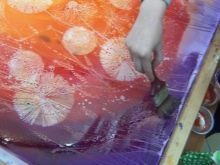


Cold batik
A suitable way to create decorative images on silk. For quality work, it is necessary to use dyes, made on the basis of aniline. The backup composition used for the cold process may be thick or liquid.
The thick consistency suggests that the basis of its composition are rubber elements. In a liquid reserve, the base is the gasoline component. In this case, the thick mass is stored in tubes with a thin nose through which the substance is applied to the outline of the pattern. The liquid substance is poured onto the fabric using a special glass tube.
It is worth noting that cold batik involves the use of not only a colorless redundant composition, but also colored substances. Dyes are applied to the fabric in a single layer, which is why the master needs to be very careful in the process.



Free painting
This variety of batik is widely used on natural silk and synthetic fiber fabrics. As dyeing compositions, masters use oil paints or dyes made on the basis of aniline.


Nodal Batik
Quite an interesting and very common way of performing unusual images on fabric. Matter is tied in several knots, each of which is sequentially tied with a thread. Dyes are applied on top. After complete drying, the threads are cut off, and the knots are untied.



Shibori Batik
The presented method of performing unusual images on fabric can be used by any person who does not even have an artistic vein, although creative notes are present in each individual person.
The prepared material is initially crumpled, then twisted, then pulled and wound. After these manipulations, the canvas is immersed in the coloring composition.By unfolding the fabric after drying, the performer of the work is sure to be speechless. Similarly, you can dye any fabric materials, clothes, bags and much more.


Tools and materials
Despite the apparent ease of performing a pictorial drawing on fabric material, batik involves the use of a variety of tools and materials that are required to be present in the arsenal of the artist.
Warp fabric
The material for drawing can be very different, although the most preferred are natural fabrics, such as silk. Beginners are better off using artificial materials, such as chiffon or crepe de chine. The canvas chosen for work should first be washed, then fixed to the frame, slightly stretched.
Due to this, the dye composition penetrates deep into the fibers and stains the fabric as much as possible.

Stretcher
Unfortunately, one cannot do without this subject. After all, the fabric selected for work should expect staining in a taut state. The subframes for batik in appearance resemble window frames, where on one side of the plane there is a bevel so that the stretched fabric does not touch its base. If there is no subframe, you can use the sliding frame. You can buy it in a specialized boutique.
An important advantage of the sliding subframe is the ability to change the length and width of the working area. Experienced craftsmen with high skills in batik technique use a hoop.
Only the tension on them is not as maximum as we would like. In addition, the small hoop size significantly limits the possibilities of the creator of the masterpiece.


Brushes
To perform work in the batik technique, they are considered the most important and basic tools. Therefore, you can not save on them. And it’s undesirable to buy budget sets of brushes of different sizes. When applying the coloring composition, the tip of the brush should move smoothly and subtly along the base of the canvas, and the irregular shape of the pile can ruin the artistic design.
The same applies to hairs emerging from a bundle. Brushes designed for painting on fabric are quite expensive. Only masters will have to spend one time to complete several hundred works.


Coloring composition
Turning to any art boutique, a novice master will be able to get acquainted with a variety of colors intended for batik. Acrylic based paints and water-soluble coloring compounds are only the best choice. Moreover, water-soluble are much better suited for subtle types of matter. Acrylics in consistency resemble gouache and are used to work with dense fabrics.


Glass tube
The tool used to apply the reserve along the contour of the pattern on the canvas. When purchasing a glass tube, you need to pay attention to the diameter of the nose. The thinner it is, the narrower the separation band between colors will be.
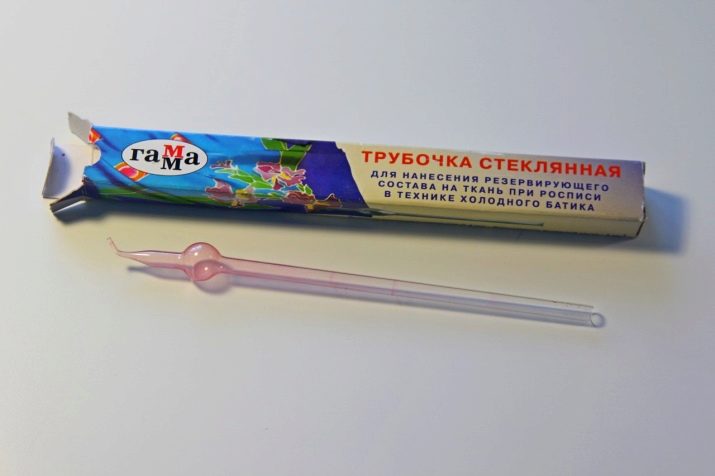
Paraffin or wax reserve
These materials are used in the performance of hot batik. Some masters prefer to work exclusively with a wax substance, others mix it with paraffin. And all because pure wax is very difficult to clean at the end of work. It is impossible to say for sure how much reserve is required for work.


Outlines
Typically, this material is used to perform work in the cold form of batik. Get them in the same place where the coloring compounds. Contours, as a separate material, are offered to masters in various variations of effects and colors.
Professionals advise not to purchase many different types of contours at once. It’s better to wait until the muse comes and gives you an idea for creating a masterpiece. Unfortunately, unnecessarily long contours dry up.


Chanting
A tool designed to work with liquid wax.


Buttons
Used to fix stretched fabric to the frame. Can be purchased in any office supply store. They can be oblong in shape or metal with a round hat. In this case, you can use any fasteners that are convenient for the master to use.



Various little things
In this case, simple pencils are supposed to be used, a palette that allows you to mix different coloring compositions, tracing paper, eraser, felt-tip pens, thanks to which you can circle a pattern of your design, twine or ordinary threads to create nodular batik, alcohol, hair dryer and water, preferably without impurities.


New craftsmanship
Today, art stores are constantly replenished with various materials and tools to facilitate the work of the master. The presented novelties allow turning the artist’s most complex fantasies into reality. One such innovation is phantom marker. After applying the image to the fabric and processing it with a reserve composition and coloring elements, the marker evaporates. Strong demand among artists began to use durable subframe clawswhile they do not damage the fabric and do not leave holes.
Hot batik lovers will appreciate electrically connected wax bath. For creative personalities involved in batik professionally, created airbrush with a number of features, allowing you to spray the dye composition on the fabric surface in large quantities. A distinctive feature of the airbrush is the uniform application of paints on the work surface. After drying, in the finished drawing there are no gradient spots and streaks.



Technique for beginners
Novice masters, as well as people who do not have an art education, but who want to prove themselves in art, will be able to create unusual masterpieces by using the most interesting variety of batik techniques to decorate linen or clothes.
Moreover, it is not necessary to have a special workshop, it is enough to make a small working corner at home, where no one will bother you or bother you. A few hours of solitude will allow you to create an unusual pattern on the fabric with your own hands.
Cold batik
The presented version of painting on fabric is suitable for people with patience, since the process of work itself is quite laborious and takes a lot of time. As a reserve, compositions are used that should not be heated or melted.
Before starting work, the wizard needs to create a workspace. The place should be well ventilated, for example, a balcony or a loggia. And all because of reserve fumes, which have a negative effect on the human body.
Next, you will need to prepare the necessary tools:
- pencil;
- reserve;
- glass tube for applying a reserve;
- core brushes;
- subframe buttons;
- fabric (silk will become the most suitable).
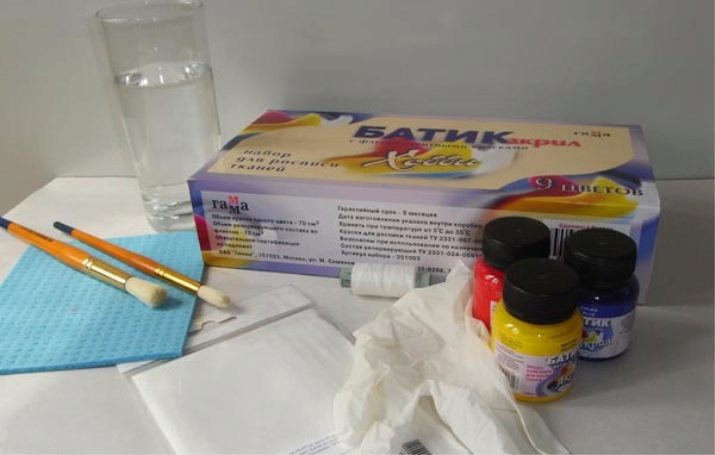
Having chosen a suitable drawing, the master needs to transfer it to paper, as a template. The entire contour of the image must be closed. Subsequent application of the reserve must be made without delay, but do not rush at the same time. In order to prevent mistakes, it is proposed to familiarize yourself with the correct sequence of actions.
- Initially, the canvas selected for work must be washed, pulled onto a subframe.
- A backup substance is collected in a glass tube, and then applied to the sketch outline.
- To increase the number of shades on the palette, you will need to dilute the same color with a different amount of water. To create them in large quantities, you can use small jars of yogurt or disposable cups.
- When applying paints, it is important to initially apply light colors with a smooth transition to dark shades.
- After applying the paints to the surface of the finished image, it is necessary to pour out a little salt, let the paints dry, then shake off the sand grains and remove the canvas from the stretcher.
- After finishing the painting work, the remaining reserves from the tube must be removed, otherwise it will harden.
- After a day, the tissue should be boiled, then washed in warm water.
- When rinsing in water, add a little vinegar. Then squeeze the material from the water and iron.


Hot batik
The painting on everyday clothes does not just look beautiful, but extremely impressive. Artists who want to transform their wardrobe should carefully study the technique of hot batik. This method is very convenient, since it does not require painstaking work with coloring individual pieces of canvas. Many creative personalities, wanting to have unique things that have no analogues, initially purchase fabric, then decorate the fabric, and then sew clothes from it.
The only thing you need to exercise caution is working with molten wax. The rest uses the most standard tools. The most suitable fabric for work is cotton, wool or silk.
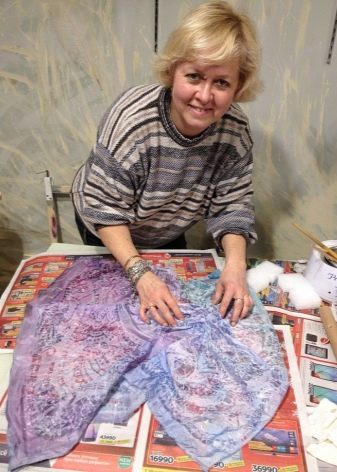

An important step in the work is the preparation of tools.
- matter;
- paper stencil;
- paints;
- glass;
- Chanting
- brushes;
- cellophane and newspapers;
- hair dryer and iron;
- wax.
Before starting to create a masterpiece, the master needs to change into a working form.
- First you need to take the chanting. It resembles a miniature watering can with a thin nose. Although it is much more convenient to use brushes with a thin pile, thanks to which it turns out to apply even drops on the canvas. And only after that the coloring composition is used.
- Further paints are applied.. If necessary, you can re-apply wax on some areas of the working surface and paint with other coloring substances in composition.
- After the paint has dried, remove the wax. To do this, put the canvas on newsprint and iron it. Then change the newspaper sheet and iron again.
This procedure must be carried out until the wax reserve is completely eliminated.
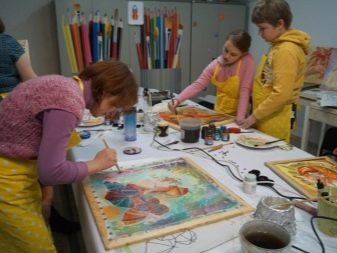

Free painting
The most common today is considered free painting with soaking in saline liquid. A feature of the technique lies in the fact that the stretched fabric should be saturated with water-salt liquid, after which a coloring composition is applied to it. To draw such beauty is a pleasure, since even the most fastidious artists will like the finished result. To understand the intricacies of free painting, it is proposed to study several options for its execution. First you need to prepare working accessories:
- aniline-based dyes;
- saline fluid;
- silk fabric;
- sketch;
- brushes;
- pencil.

Novice masters will first prepare to prepare saline fluid. To do this, you need to take a few tablespoons of salt and dilute it in a glass of hot water. But there is an important nuance - hot liquid must be poured into an enameled container or glass dish to make it more convenient to mix, and then apply to the fabric. Then, with a pencil, a sketch of the prepared image on the canvas is made.
- In the first case you should familiarize yourself with wet painting. Before starting work, the fabric is soaked in salt water, and then without waiting until the fabric dries, they begin to work. By the way, even for the dilution of dyes, it is necessary to use salt water. When applying the picture, you should use a wide brush and make rough strokes for it. Thanks to this, the drawing will receive an unusual design.
- In this case, painting on semi-dry matter is supposed. While the silk is still slightly wet, salt crystals appear on it, due to which the applied coloring composition does not spread in different directions, although a bright trace remains from the brush,which after a while creeps a little. This method is ideal for creating simulations of natural contours.
- The third way talks about working with dry matter. After the cloth dries, the fabric becomes crispy, and the dye only spreads slightly on its surface. The drawing procedure should be continued by applying rare smears.


Original ideas
Today, all hand-made work, such as knitwear or embroidery on fabrics, are very expensive. The same applies to paintings created using the batik technique. The creator of a colorful masterpiece puts a lot of time and energy into his works of art, is it worth talking about materials and tools.
But despite the high cost factor, each person with great pleasure will purchase a T-shirt or shawl with a “hand made” print for himself.
In the first case, it is proposed to consider a finished canvas made using the technique of cold batik. Each brush stroke is accompanied by a smooth transition from dark to light shades. A close examination reveals a clear line of the reserve composition, due to which there are borders in each element of the picture. The background part of the scarf is made in the most unusual and smooth transitions of light tones of the palette, with which the artist worked for more than one hour.

People with no art education will not be able to find the difference between cold and hot batik techniques. This can be done only by sophisticated masters of their craft. In this case, it is proposed to consider the option of a drawing made using the technique of hot batik. Its main distinguishing feature is the ability to use the finest lines of wax, which are barely noticeable in the finished picture.

The third option is made in free technology. And this is visible with the naked eye. Looking at the flower, the silhouette of the artist immediately arises in his thoughts, which, with neat strokes, applies coloring compounds to the canvas. And the saline solution used in the work only helps to create smooth transitions between colors that are similar in shades.
The most difficult in this case was to depict the water balance between the waves in the distance of the image and the calm in the foreground.
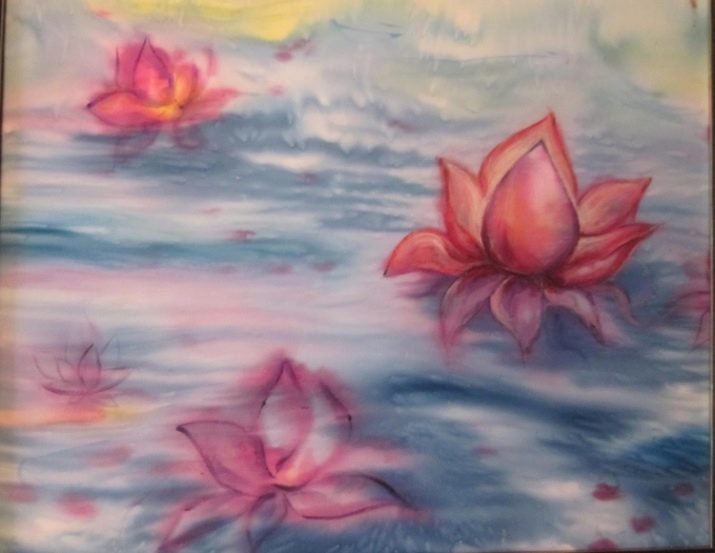
In the next video, you can get acquainted with the secrets of the work of an experienced master in creating murals.










